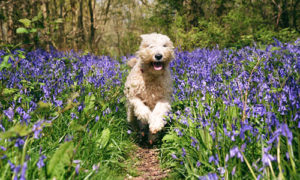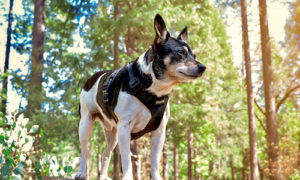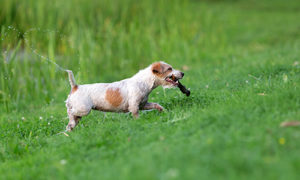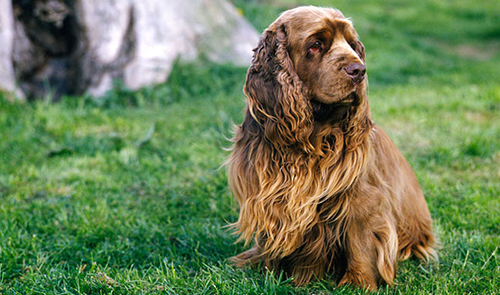
The Sussex Spaniel is a dog developed by one breeder in Sussex, England, in the 18th century. Famous for its rich golden-liver color and distinctive voice, the Sussex was utilized for hunting in the underbrush and thick hedgerows. It became well-known for its determination, steadiness, and keen sense of smell. The Sussex Spaniel could quickly be followed on foot and would intuitively bark to let the hunter know when it found the scent of the quarry.
The breed was one of the first recognized by the AKC. However, its popularity was eclipsed by the faster gundogs in the 19th century. A handful of breeders preserved the breed in America throughout the 1930s and 1940s. Thankfully, during the early 1970s, the breed experienced a revival in America, when a foundation stock from England was imported. Currently, the breed is considered rare and is classified as a vulnerable native dog in Britain.
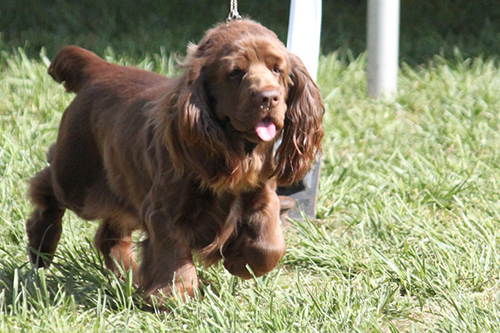
Breed Standard
The Sussex Spaniel is a low, long, massively built dog with a strong, short neck, a level back, a round chest, short legs, large, rounded feet, and a low-set tail docked 5 to 7 inches. The dog’s trademark frowning, somber expression is produced by a combination of head traits: a wide, long skull with heavy brow, a broad, square muzzle, 3 inches long, large, hazel colored eyes, and large, thick, low-set ears.
Breed Facts
- Popularity: Rare
- Family group: Spaniel
- Area developed: England
- Date developed: 1800s
- Original purpose: Small game tracking and flushing
- Today’s purpose: Bird flushing and retrieving
- Other names: None
- Activity level: Moderate. This dog loves outdoor activities like running; however, they are well-mannered and calm inside the home. They love to compete in fieldwork, hunting tests, tracking, rally, agility, and obedience. Some dogs tend to throw themselves forward with their front legs while dragging their back legs stretched out behind them, which is known as kippering, and it is a typical breed trait.
- Grooming: Brushing weekly is recommended
- Coat: Abundant, flat, or slightly wavy body coat with a longer coat on the legs, tail, ears, and neck.
- Color: Golden liver
- Group: Sporting
- Year recognized by the AKC: 1884
| Energy level | Watchdog ability> | ||
| Exercise requirements | Protection ability | ||
| Playfulness | Grooming requirements | ||
| Affection level | Cold tolerance | ||
| Friendliness toward dogs | Heat tolerance | ||
| Friendliness toward other pets | Friendliness toward strangers | ||
| Ease of training |
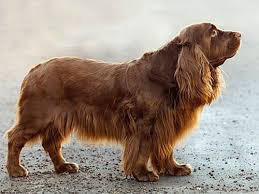
Sussex Spaniel Temperament
This breed is cheerful, friendly, and tractable, all traits of a typical spaniel. The Sussex is dignified and polite, though they can be bossy. They are far more robust than they look and can be stubborn. These spaniels are not very easy to train; females are more difficult to housetrain than males. Training is a top priority, and positive, short training sessions are recommended. Harsh training and punishment are not recommended because of this breed’s soft temperament.
Health
- Main concerns: CHD, intervertebral disk disease
- Minor concerns: otitis externa, heart murmurs, enlarged heart
- Rarely seen: PDP1
- Recommended tests: hip, cardiac, (PDP1)
- Life span: 11 to 13 years
- Weight: 35 to 45 pounds
- Height: 13 to 15 inches
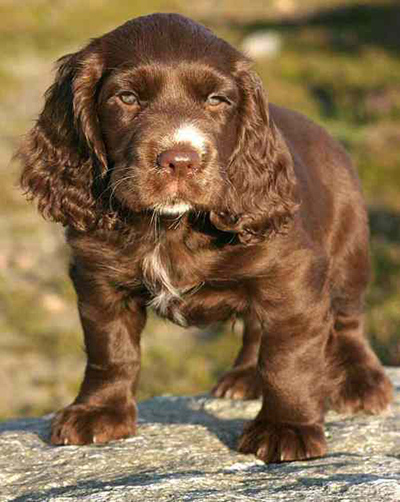
Breeders and Buyers Advice
The Sussex Spaniel demands companionship and will howl and bark if ignored. This breed matures slowly into a powerful and impressive dog. Prepare yourself for a long wait for a puppy because only 75 puppies are born in America every year. A highly regarded breeder will have plenty of questions for all potential owners; therefore, it’s essential to do your research and know if you’re the right person for a Sussex.
- Parent club: Sussex Spaniel Club of America (www.sussexspaniels.org); founded in 1981
- Regional clubs: There are links to local clubs on the parent website
- Rescue: You can find Sussex Spaniels rescue information on the parent club website at the bottom of the home page

